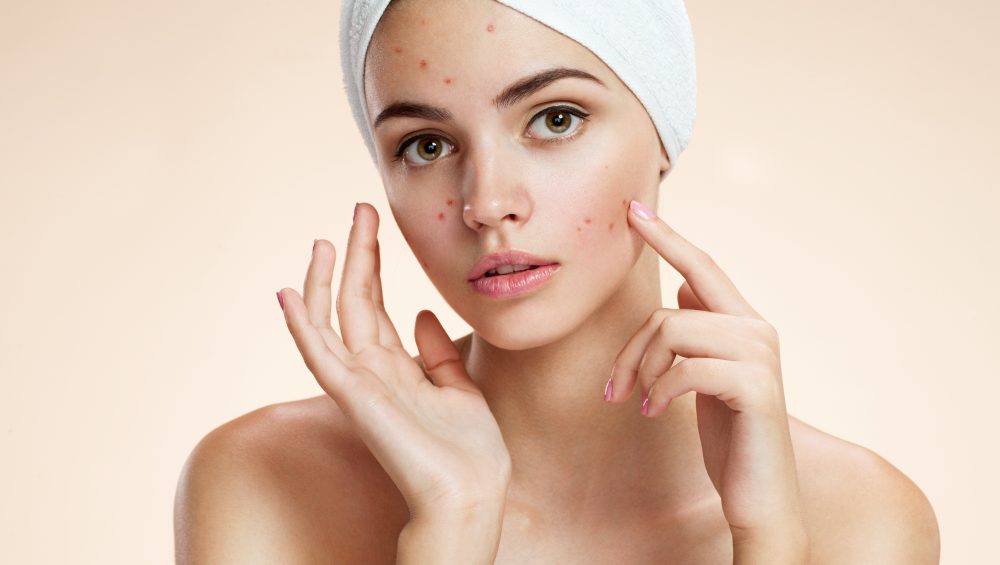Acne is acne, right? Well, sort of. It turns out that where your face acne is popping up may be especially important to treat because that’s one of your biggest clues as to what’s causing it. But there are also plenty of environmental, behavioral, and internal factors that can make you more prone to breakouts in specific regions of your face. In this article, we will tell you about the four regions on your face where you might experience acne.
First, we will take a look at cheek acne. Next, we will discuss forehead acne. Then, we will cover chin acne and wrap up with nose acne. Once you have finished reading, you will know the four regions on your face where you might experience acne.

1Cheeks
We can’t nail down what causes acne in this area, but there are a few possible sources. In general, cheek acne usually happens, thanks to genetics, because that’s simply where your skin tends to develop acne. However, it could also be due, at least in part, to your everyday habits. Anything that’s pressed against your face for an extended period can cause a buildup of oil, bacteria, and dead skin cells, which can ultimately result in acne. So your phone, pillows, sheets, and even your hands (if you hold or touch your face throughout the day) could be playing a role in your cheek acne breakouts.
Luckily, the solution to this problem is relatively straightforward – keep all of these items clean and avoid touching your face as much as possible during the day. This will reduce the number of bacteria and oil introduced to the skin. One other thing to keep in mind is that rosacea, which can cause small, red, acne-like bumps, often shows up on the cheeks. So if you’ve tried to tackle acne in this area without success or if you find that your face also looks flushed or frequently feels sensitive on the cheeks, it’s worth getting checked out by a dermatologist to see if there might be something else going on.

2Forehead
Forehead acne is common in basically anyone with oily skin. But your hairstyle can also exacerbate the issue. In particular, it’s common to find people who feel self-conscious about their skin in this area and get bangs to cover it up. But that only makes matters worse since the bangs will trap dirt, oil, and hair products in the area. Forehead breakouts can also be caused by yeast that falls from the scalp and gets trapped in the pores along the hairline when excess sweat and oil accumulate in that area.
This type of fungal acne (which technically isn’t acne) probably won’t be inflamed but will make the skin on your forehead feel “bumpy and rough” instead. Fungal acne is best treated with a sulfur-based wash known as sodium sulfacetamide. To prevent forehead breakouts of any variety, try avoiding heavy hair products, like pomades or styling creams, and keep your hats clean (especially if you wear them during workouts).

3Chin
Ah, the dreaded acne around your mouth, chin, and jawline – some refer to acne that occurs in this region of the face as “the beard distribution.” This is most often caused by changes and fluctuations in hormone levels. For that reason, the most common form of treatment is oral contraception.
The best results have been seen with combination birth control pills, of which there are three varieties that the FDA has specifically approved for treating acne. If your dermatologist believes that there may be a hormonal component to your acne, they’ll likely recommend that you see your ob-gyn for a prescription. Although this form of acne is generally hormonally driven, keeping up with other acne-prevention strategies (regularly cleansing and exfoliating, keeping your phone and pillowcases clean, etc.) can also help prevent acne in this area.

4Nose
Nose breakouts tend to be on the smaller side and non-inflamed. Big cystic lesions aren’t common on the nose. It’s mainly blackheads, which are more common in people who have super oily skin. There are more sebaceous glands around the nose than on the other parts of the face, which makes it an especially oily place for anyone.
The real trick to treating nose acne is to resist the urge to pick or squeeze your blackheads. The more you mess with the pores on your nose, the more likely they are to dilate, accumulate even more oil, dead skin, and bacteria, and then get inflamed. Instead, it’s better to use gentle chemical exfoliation (look for ingredients like salicylic acid, lactic acid, or glycolic acid) to gradually and gently unclog the pores. And for those who wear glasses, make sure that your specs aren’t too tight or resting too heavily on the bridge of your nose. Unnecessary pressure can keep your dead skin from shedding normally and wind up trapped in your pores, leading to (you guessed it) acne.

All acne isn’t the same. One of your biggest clues as to what’s causing it is where on your face it’s popping up. Many factors can cause you to break out in certain areas of your face. In this article, we told you about the four regions on your face where you might experience acne.
First, we looked at cheek acne. Next, we discussed forehead acne. Then, we covered chin acne and closed it with nose acne. Now that you have finished reading, you know the four regions on your face where you might experience acne.

